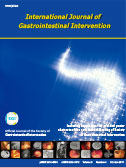
pISSN 2636-0004
eISSN 2636-0012
ABOUT THE IJGII
ARTICLE CATEGORY
ALL ARTICLES
For Contributors
-
POLICY



 pISSN 2636-0004
eISSN 2636-0012
pISSN 2636-0004
eISSN 2636-0012
 All Articles
All Articles
 Articles
Articles

Abstract :
Cited By: 3

Abstract : Pancreatic cancer has been identified as one of the most common malignant causes of upper gastrointestinal obstruction. Most common sites of obstruction include the pyloric region and second and third portions of the duodenum. If surgical gastrojejunostomy is not a viable option, metallic stent placement may be performed either by transoral or transgastric approach. Transgastric technique is considered to be more invasive and is often employed only in failed attempts to insert a stent using transoral technique. This report presents a 70-year-old patient with pancreatic cancer involving the proximal jejunum. Although this is a rarely described location for stenting, the patient was successfully treated using transgastric technique.
Cited By: 2

Int J Gastrointest Interv 2023; 12(2): 64-68
https://doi.org/10.18528/ijgii220018
George Zhang  , Hayden Matthews
, Hayden Matthews  , Osanna Wong
, Osanna Wong  , and Dylan Kurda
, and Dylan Kurda 
Int J Gastrointest Interv 2022; 11(3): 143-148
https://doi.org/10.18528/ijgii210021
Soo-Young Na  , Seong Jung Kim
, Seong Jung Kim  , and Hyoun Woo Kang
, and Hyoun Woo Kang 
Int J Gastrointest Interv 2023; 12(3): 105-109
https://doi.org/10.18528/ijgii230002
Shuji Kariya, Shintaro Yamamoto 
 , Miyuki Nakatani
, Miyuki Nakatani  , Yasuyuki Ono
, Yasuyuki Ono  , Takuji Maruyama
, Takuji Maruyama  , and Noboru Tanigawa
, and Noboru Tanigawa 
Int J Gastrointest Interv 2022; 11(4): 186-191
https://doi.org/10.18528/ijgii220052
Jen-Jou Wong  , Srujana Ganti, Damian Mullan, Derek Edwards, and Hans-Ulrich Laasch
, Srujana Ganti, Damian Mullan, Derek Edwards, and Hans-Ulrich Laasch
Int J Gastrointest Interv 2021; 10(1): 12-16
https://doi.org/10.18528/ijgii190013
Thomas G. Morgan  , Tarryn Carlsson
, Tarryn Carlsson  , Eric Loveday
, Eric Loveday  , Neil Collin
, Neil Collin  , Graham Collin
, Graham Collin  , Peter Mezes
, Peter Mezes  , and Anne M. Pullyblank
, and Anne M. Pullyblank 
Int J Gastrointest Interv 2021; 10(1): 17-22
https://doi.org/10.18528/ijgii200018


 pISSN 2636-0004
eISSN 2636-0012
pISSN 2636-0004
eISSN 2636-0012
| TODAY | 133 |
|---|---|
| TOTAL | 228,926 |
© The Society of Gastrointestinal Intervention. Powered by INFOrang Co., Ltd.